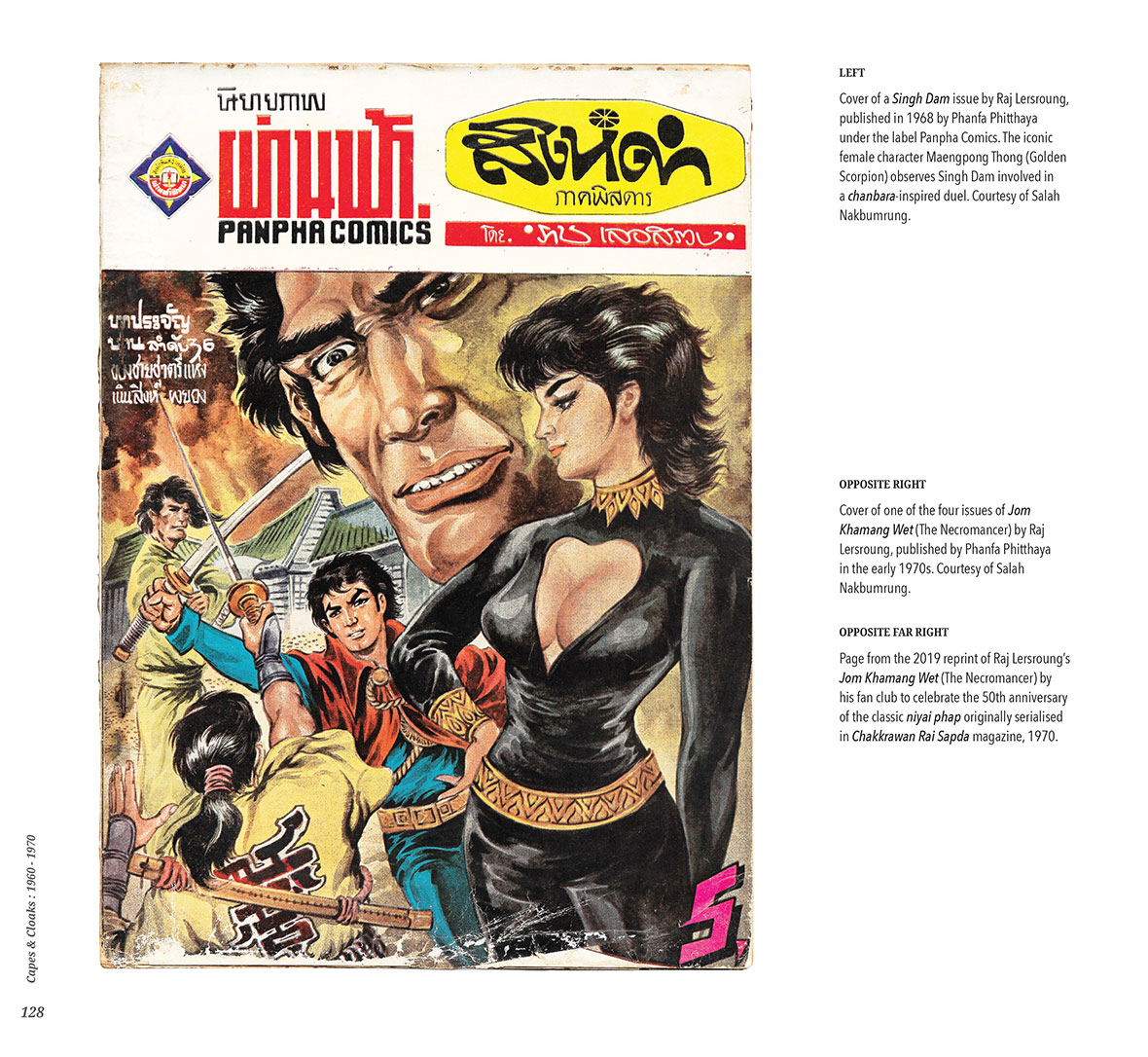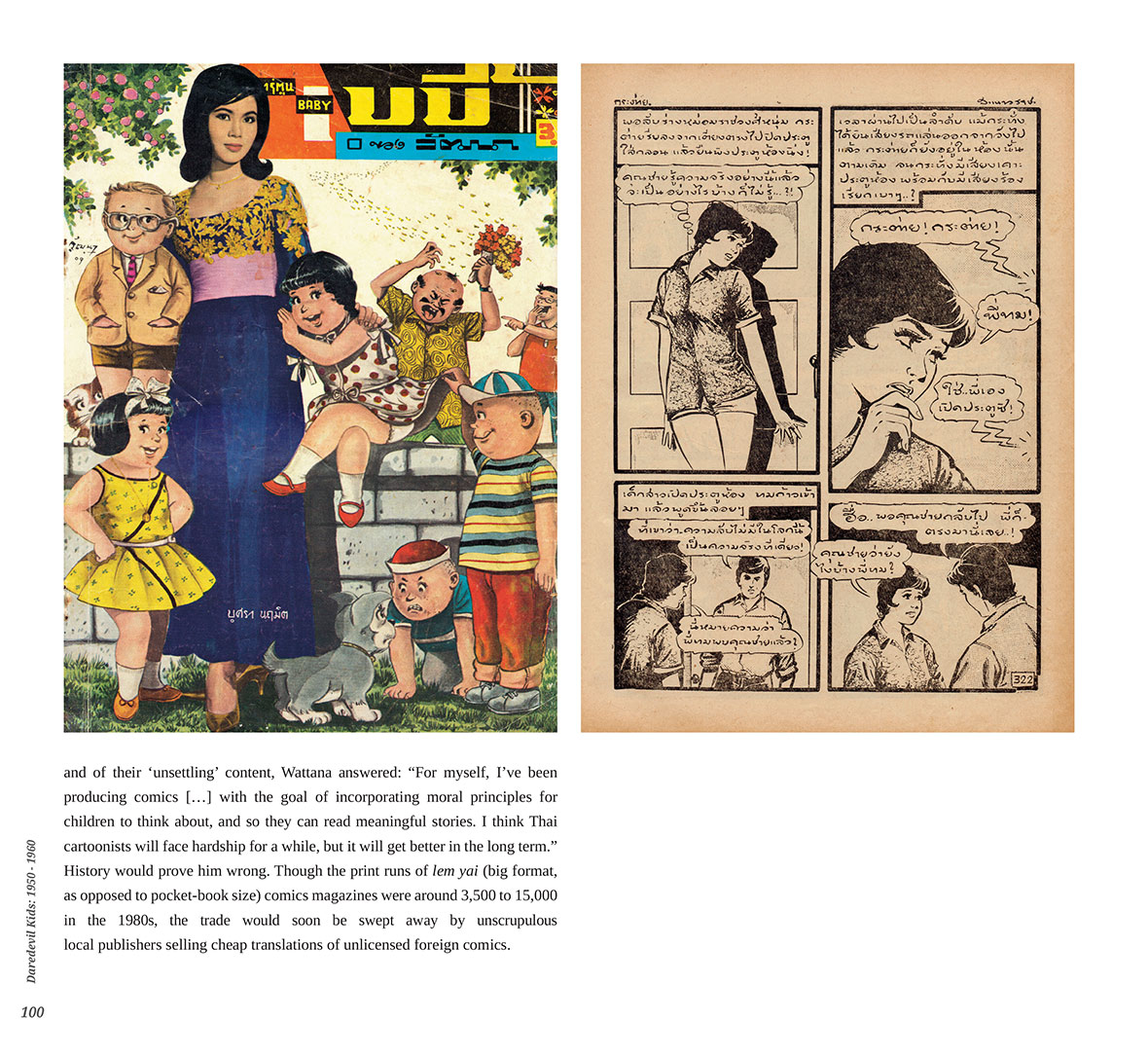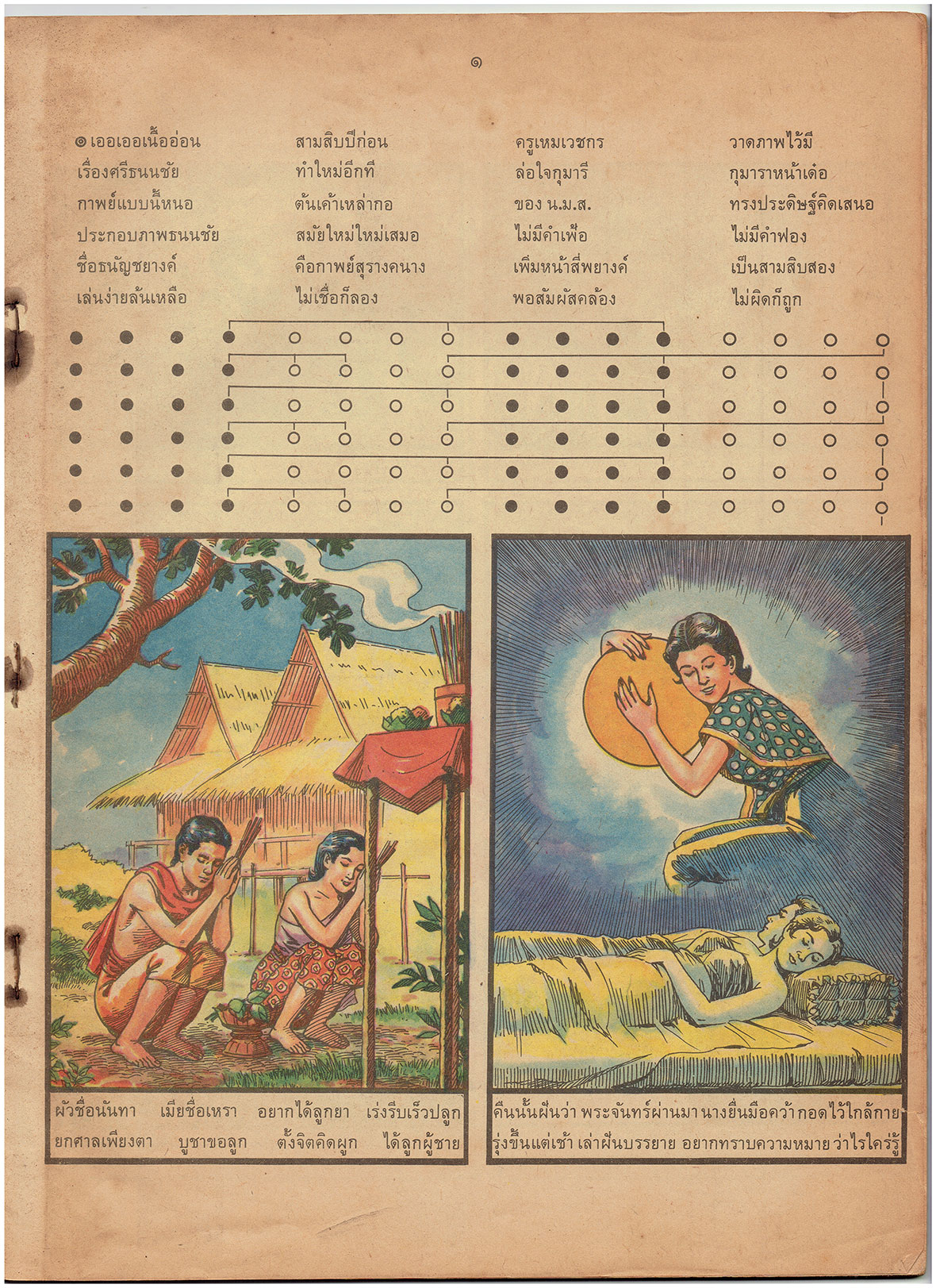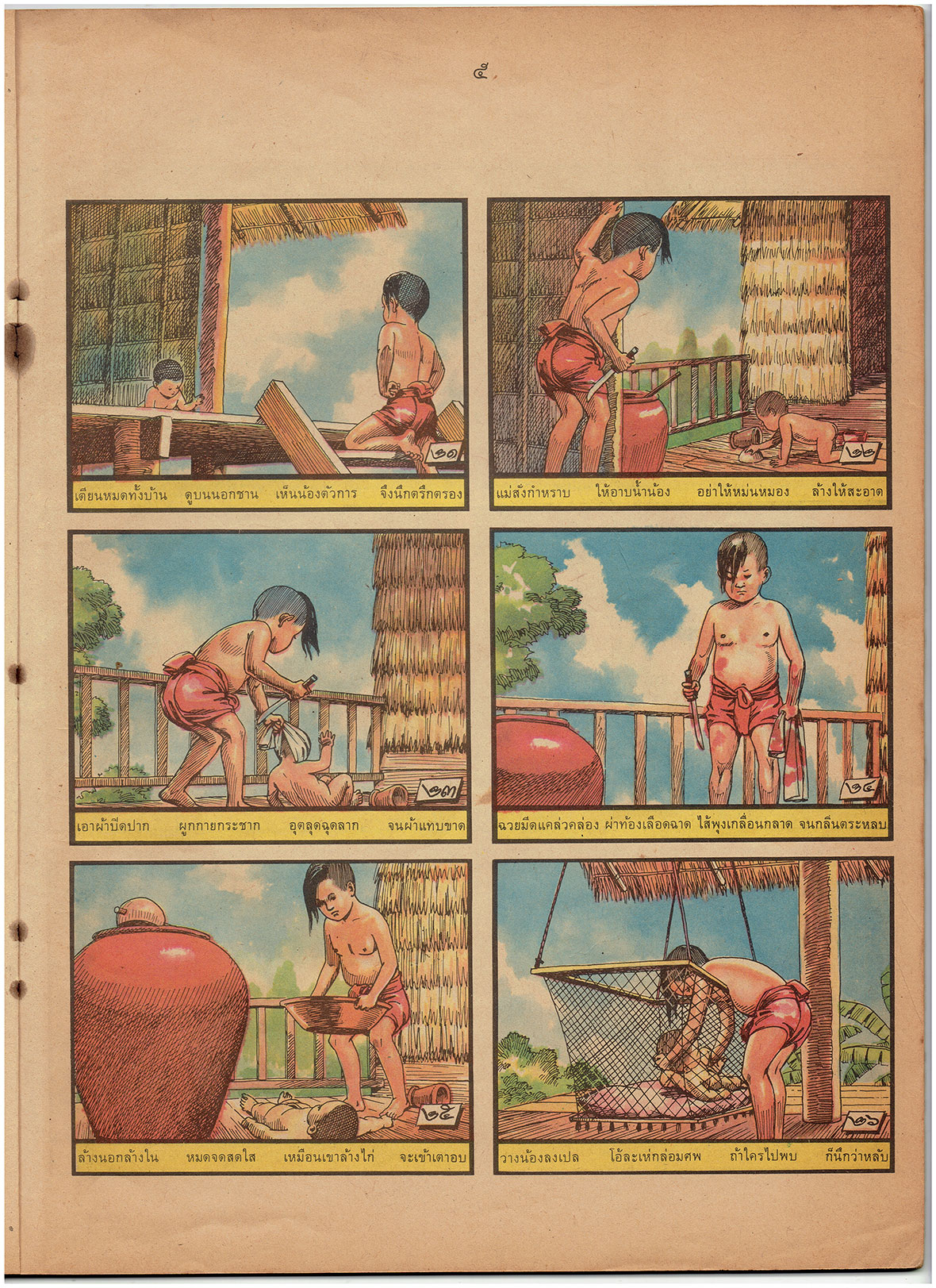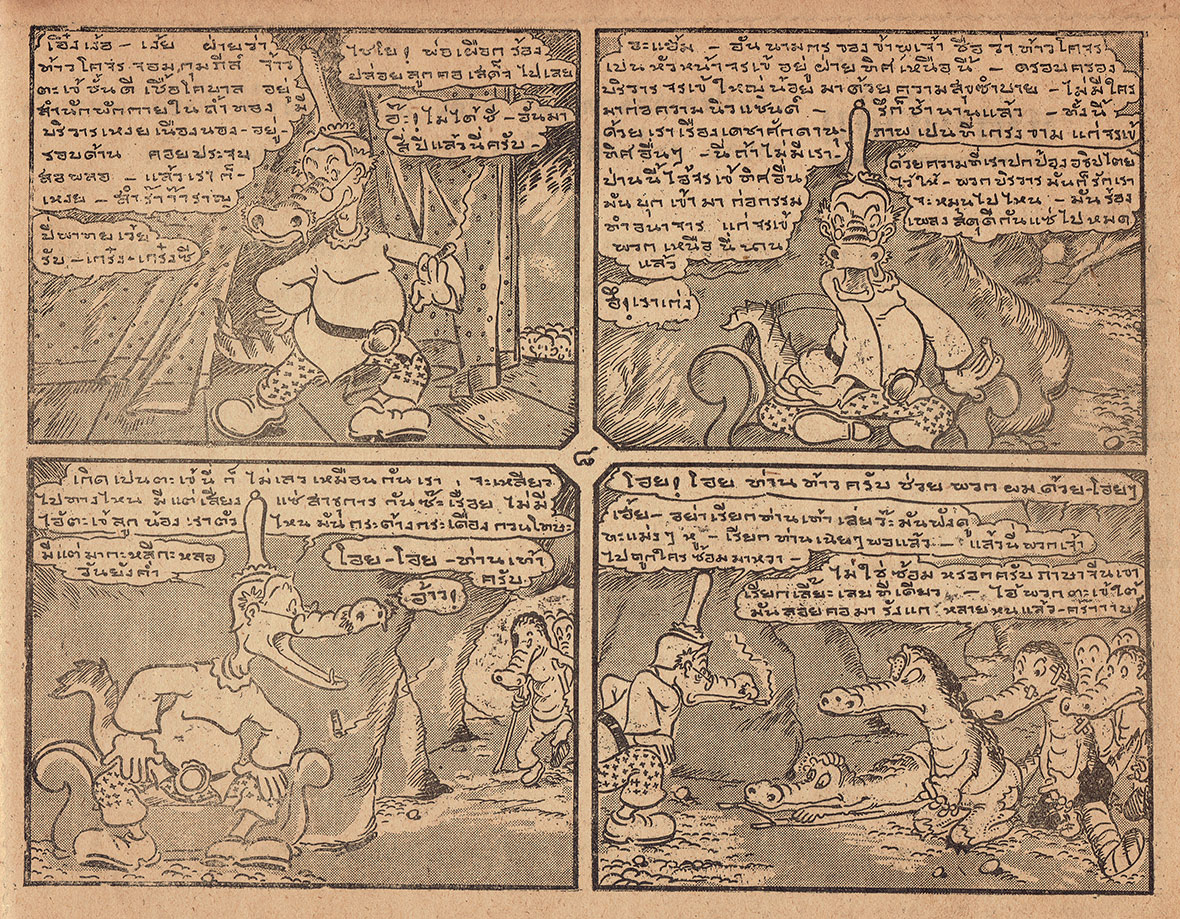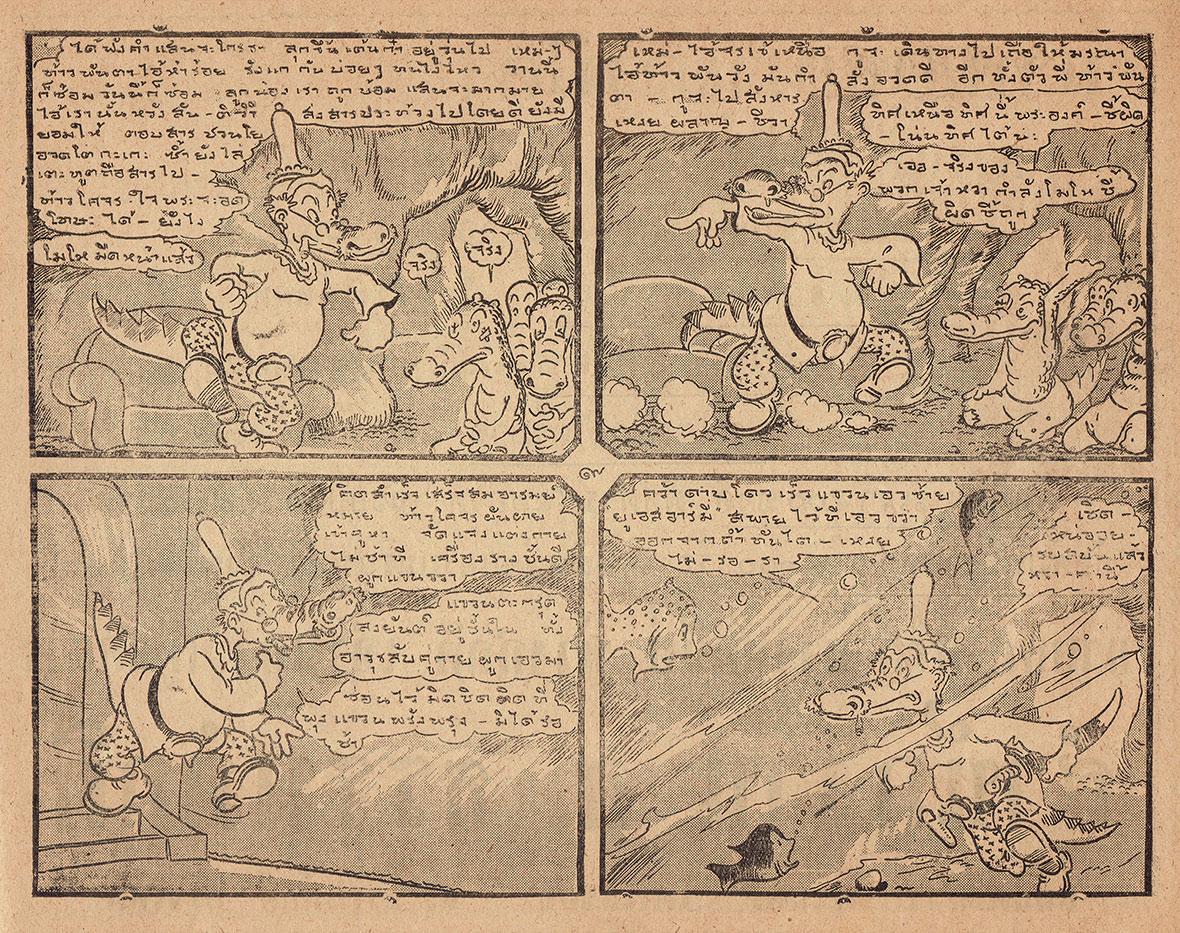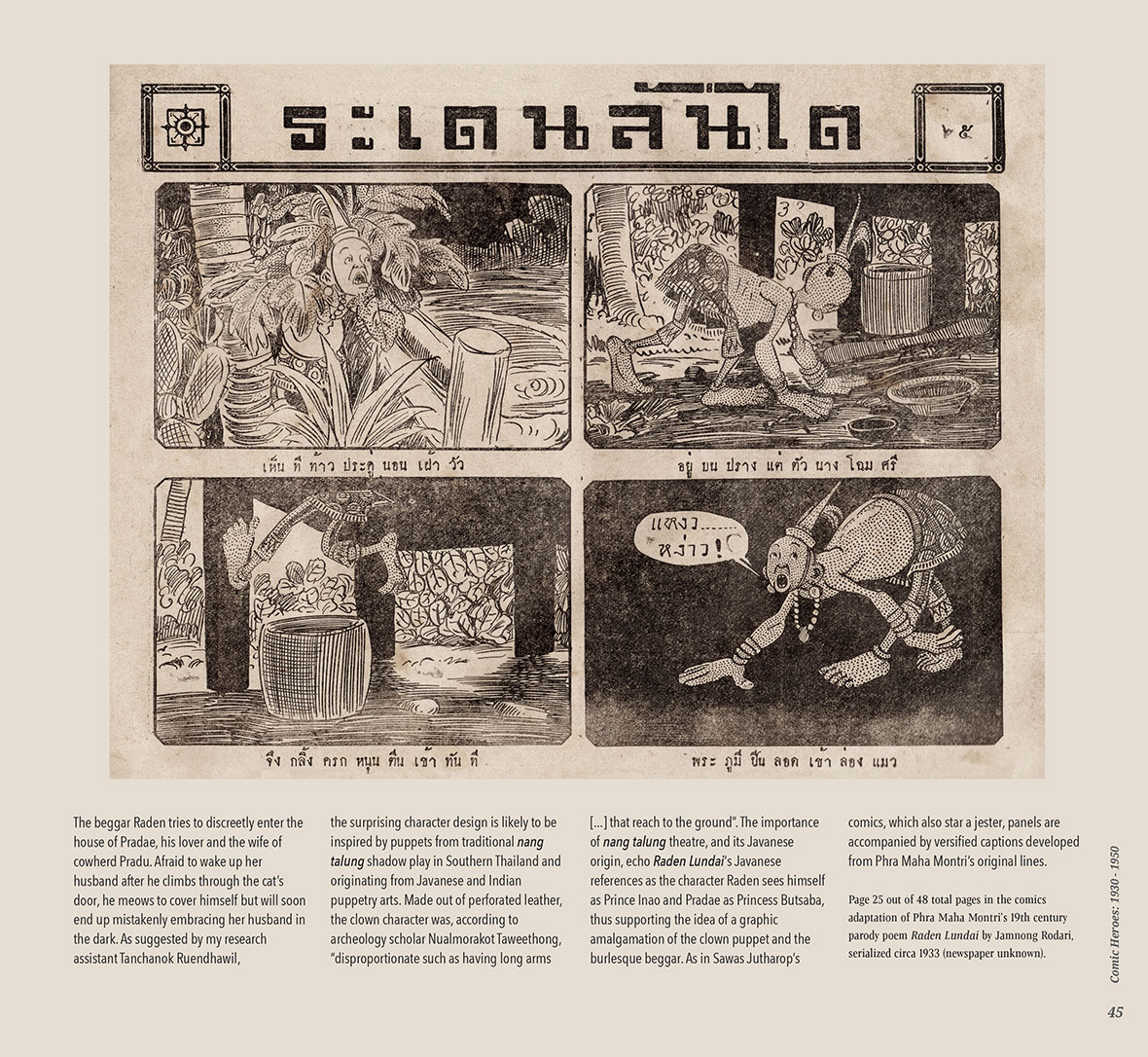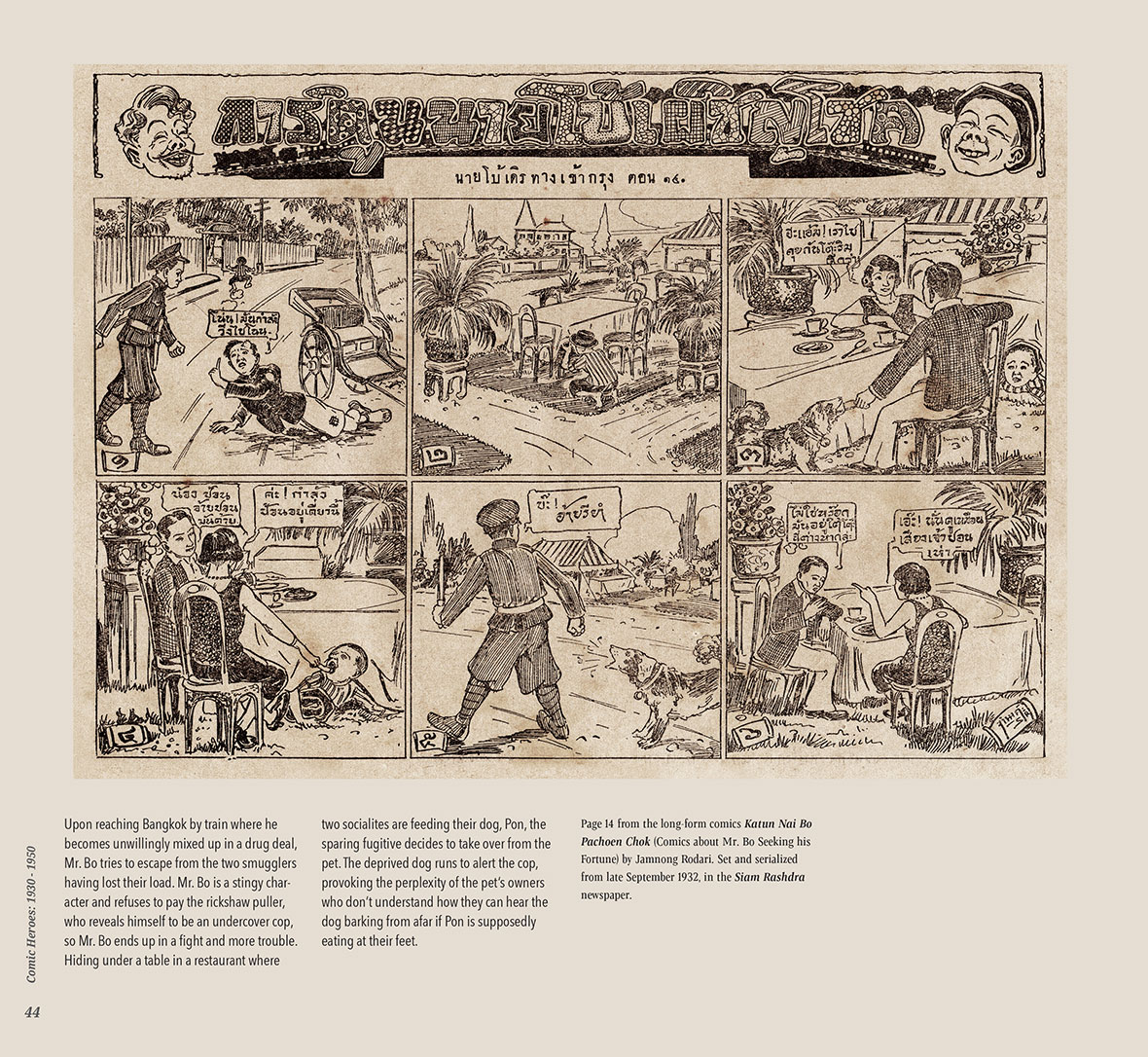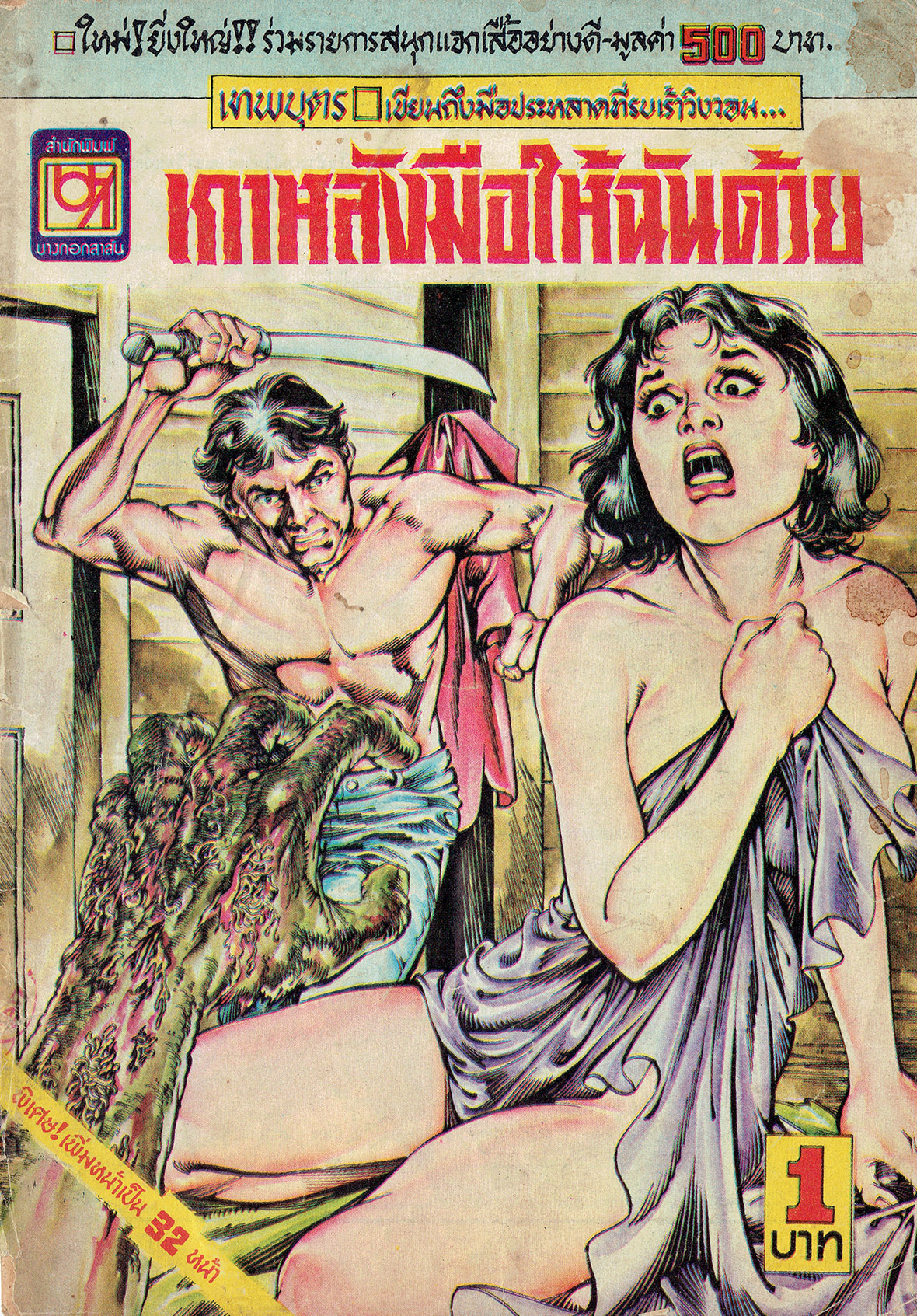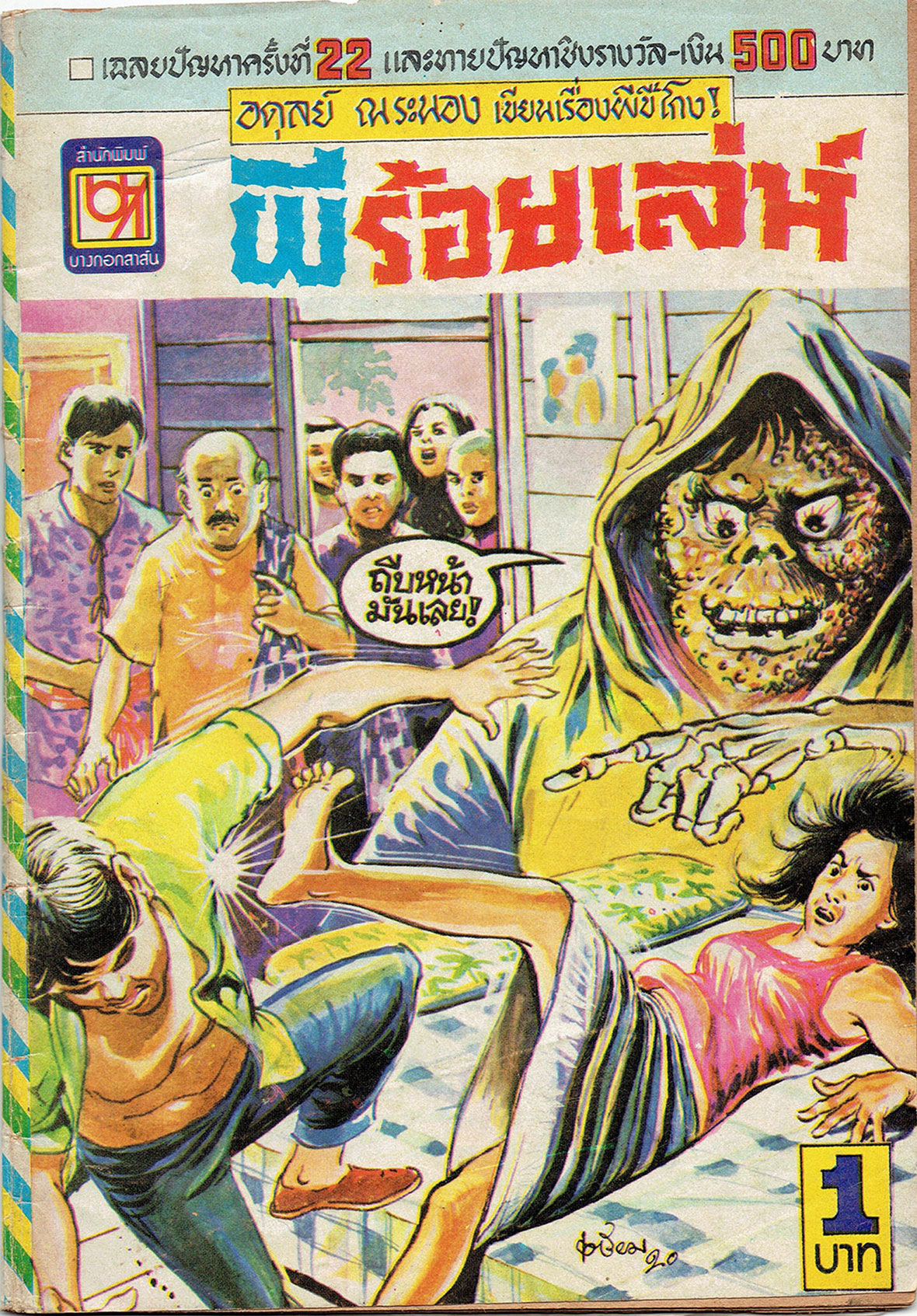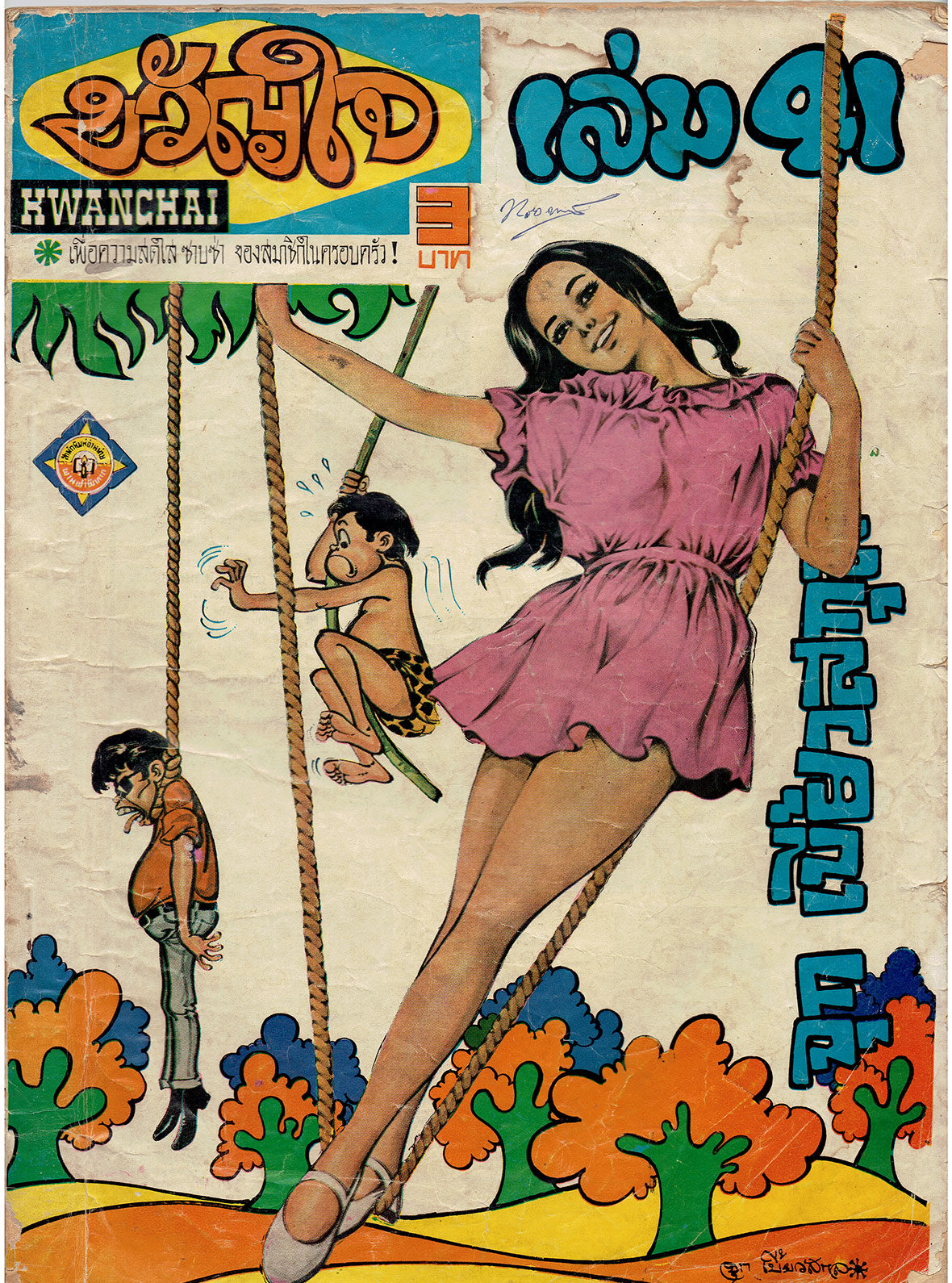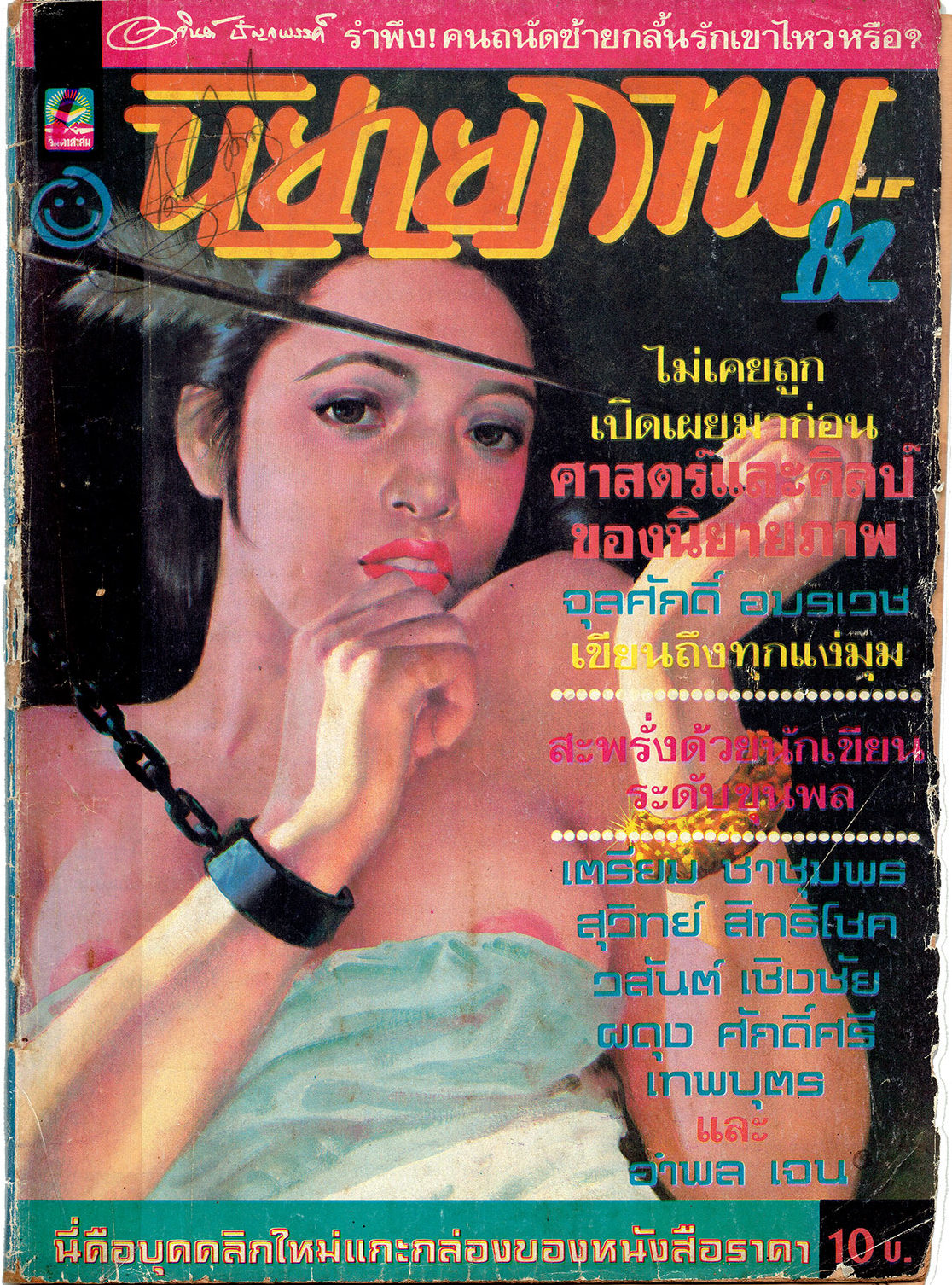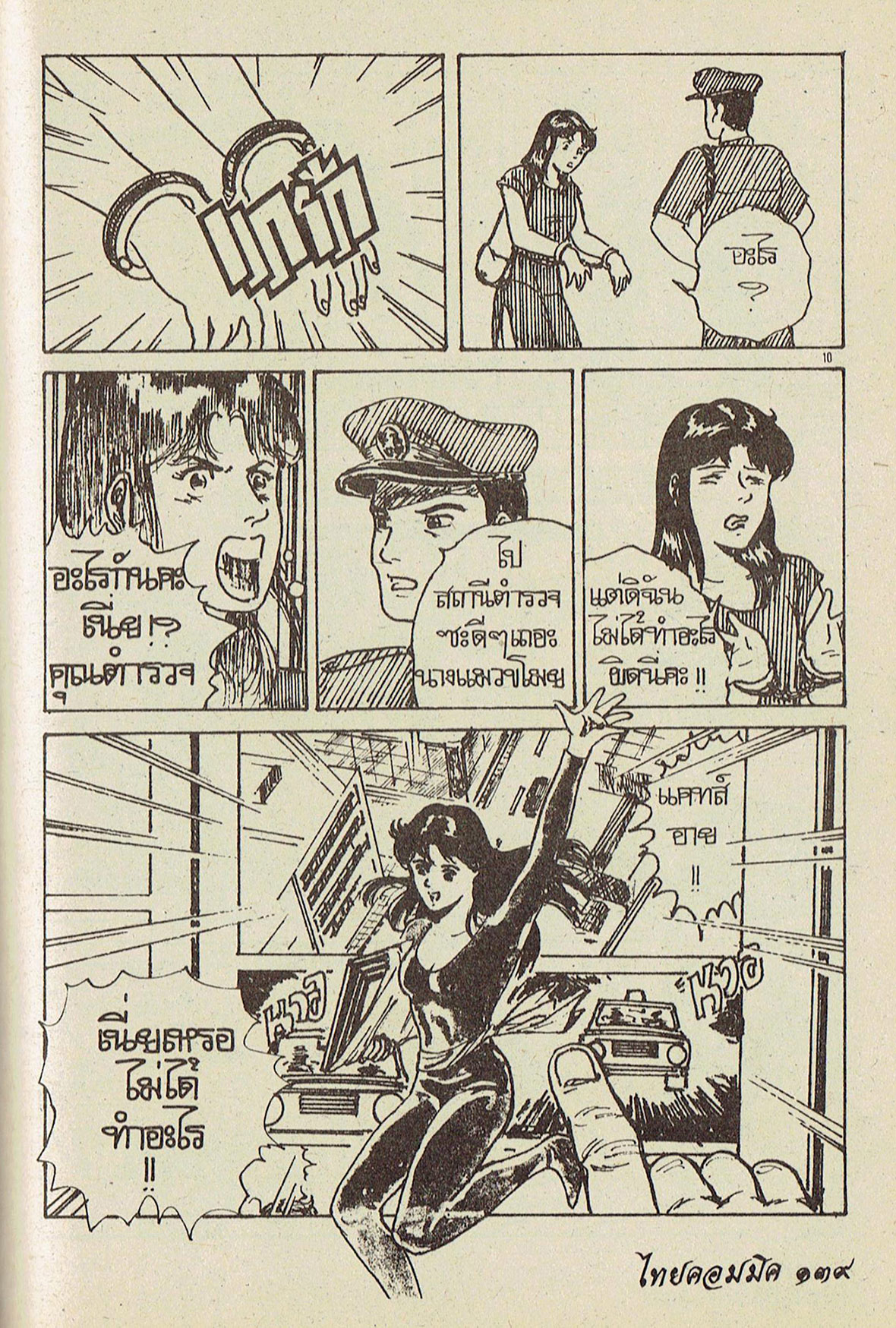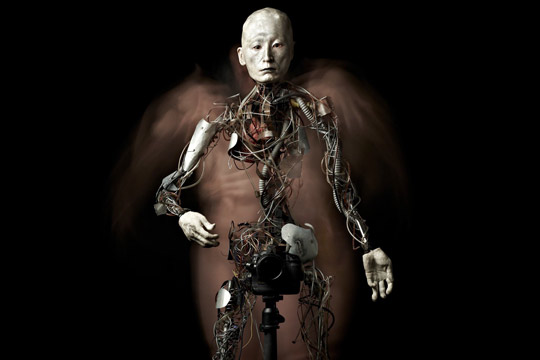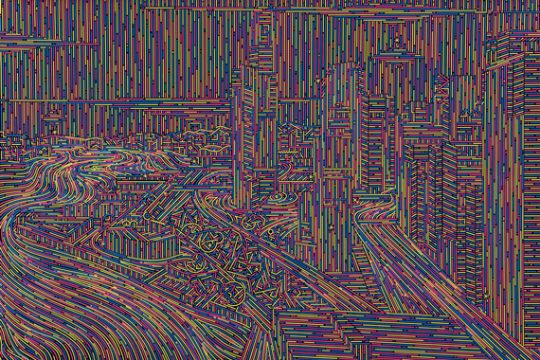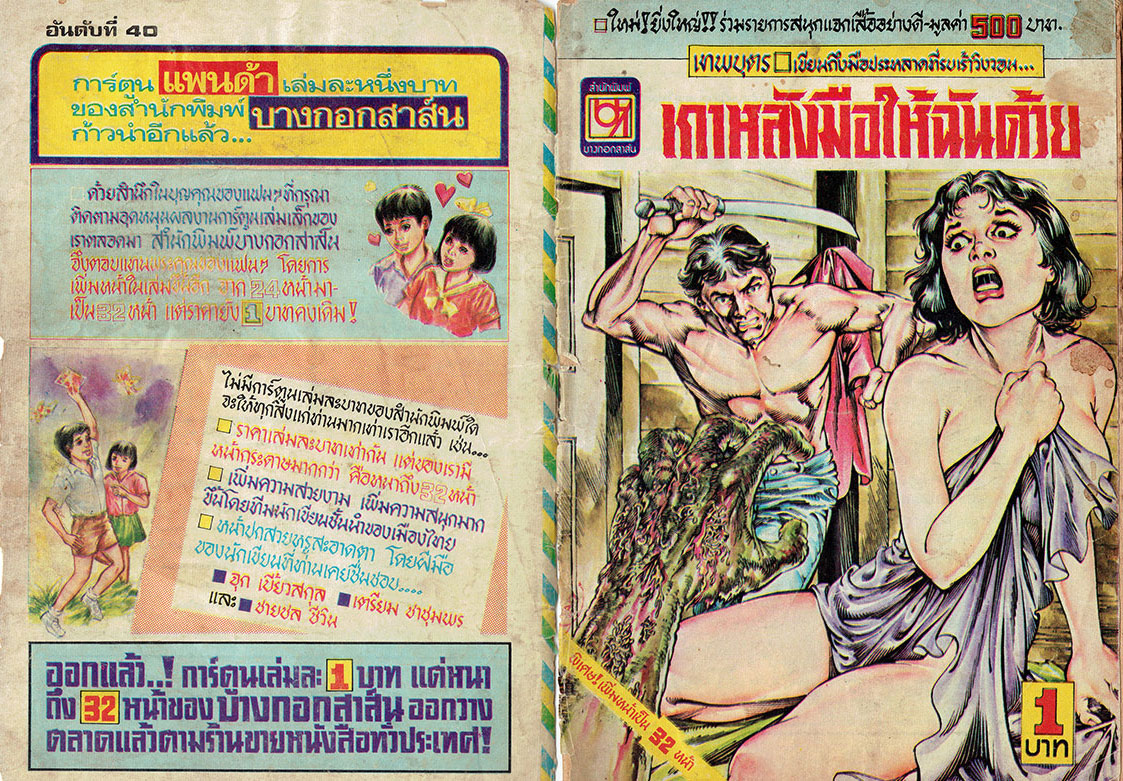
With the mention of Asian comics, most would instantly think of the Japanese tradition of manga—but not of much else. Thailand certainly doesn’t come to mind as a hotbed of creativity in the medium, but, like other Asian countries, it has developed a rich and unique comics tradition over the twentieth century, one that, despite the adversities, is still alive, and currently taking new, exciting directions.
However, the Thai comics tradition is just as little known at home as it is abroad. That’s something Bangkok-based Belgian scholar Nicolas Verstappen has been trying to change. Since moving to Thailand in 2014, he studied, cataloged, and even recovered lost parts of Thai comics history.
In 2021, Verstappen published The Art of Thai Comics, the most comprehensive book to date on the topic, in which he organizes his findings in chronological order, discussing the life and examining the works of fifty prominent Thai comics artists. The book also gives you a clear exposition of the political and social background that affected their production and includes a wonderful assortment of visual references, mostly taken from Verstappen’s personal archives.
提起亚洲漫画,绝大多数人首先会想到日本,但你可能不知道,其实泰国也是亚洲漫画重镇。早在 20 世纪,泰国便已形成丰富而独特的漫画特色。泰国漫画的发展之路堪称曲折,但一直存在,并在当下朝着新的方向发展。它在世界范围内缺乏影响力,就连在国内都少有人关注,而这正是定居曼谷的比利时学者 Nicolas Verstappen 一直试图改变的事。自 2014 年移居泰国以来,他一直努力研究、整理,励志将泰国漫画历史的面纱重新在世人面前掀起。
2021 年,Nicolas 撰写的《泰国漫画艺术》(The Art of Thai Comics)发行。这是迄今为止,关于泰国漫画最为详尽的书籍。书中,Nicolas 按时间顺序整理了他的所有发现,介绍了 50 位泰国著名漫画艺术家的生平和作品。此外,本书还清晰阐述了影响当地漫画创作的政治和社会背景,包括各种精彩的图片参考,其中大部分都来自 Nicolas 的个人收藏。
Verstappen’s native Belgium has a longstanding comics tradition, ranked among the world’s most respected, largely thanks to young globetrotting reporter Tintin. “Comics in Belgium are considered the ninth art, and reading them is a tradition passed through generations, from grandfather to father to son,” he says. He himself grew up “obsessed with comics,” as he puts it, and, by his teen years, he was very familiar with most American and Japanese titles, including Buddha by Tezuka Osamu.
To take his enthusiasm further, since there was no comics department in Belgian universities, Verstappen studied art history, focusing on medieval and contemporary art, followed by a master’s in cinema studies, including film history and scriptwriting. It was his way of finding an academic path related to comics, even if loosely. Everything was complemented by an extensive side curriculum of personal studies.
Coincidentally, the same day he presented his master’s thesis, he was offered a job at his favorite comic bookshop in Brussels, Multi BD. “I worked there for fifteen years with access to comics from all around the world, from underground to mainstream, and in almost all existing formats,” he recalls. Simultaneously, Verstappen began to interview his favorite artists from Belgium and abroad and make zines out of his conversations. He also started to research deeply how psychic trauma is shown through comics.
Even with all that, his first contact with Thai comics was when he visited Bangkok for the first time, still as a tourist, and caught sight of a cheap one Baht comic in a 7-Eleven. Years later, already living in the city and working as a lecturer at the Faculty of Communication Arts at Chulalongkorn University, Verstappen was entrusted with the seemingly straightforward task of writing a report on a subject hardly covered until then: the origins of Thai comics. “It was like opening pandora’s box,” he says. “Suddenly, I started to dig and discover that approximately seventy to eighty years of Thai comics had just been forgotten, almost completely lost.”
Nicolas 的故乡比利时拥有悠久的漫画传统,这在很大程度上要归功于享誉世界的著作《丁丁历险记》。Nicolas 说:“在比利时,漫画被视为‘第九艺术’,这里世世代代的人们,看漫画已经成为一种世代流传的传统。”他从小就是“漫画迷”,十几岁的时候,他就已经能对大多数美国和日本漫画作品如数家珍,包括手冢治虫的作品《佛陀》。
由于比利时的大学没有漫画专业,为了追求对艺术的热爱,Nicolas 攻读艺术史,主要侧重于中世纪和当代艺术,随后又获得了电影研究硕士学位,进修了电影史和剧本写作课程。在此之外,他还会通过大量的课余学习来了解漫画艺术。
巧合的是,在他提交硕士论文的同一天,他在布鲁塞尔漫画书店 Multi BD 找到了工作机会,这是他在当地最喜欢的漫画书店。“我在那里工作了十五年,接触到了来自世界各地的漫画,从地下到主流,看过了几乎所有类型的漫画,”他回忆道。与此同时,Nicolas 开始采访自己喜欢的比利时和国外漫画家,并将采访的谈话整理成电子杂志发表。另外,他还开始深入研究艺术家如何通过漫画表达内心世界、疗愈创伤。
直到第一次去曼谷旅行,他才初次接触到泰国漫画,那是他偶然在 7-11 便利店买到的一本价格仅为 1 泰铢的便宜漫画书。多年后,Nicolas 定居曼谷并成为了朱拉隆功大学传播艺术学院的一名讲师。有一次,他受任一项工作委托 —— 撰写一份关于泰国漫画起源的研究报告,这是一个很少人讨论的冷门主题。他说:“就像打开了潘多拉魔盒。通过深入的挖掘,我发现有近70 到 80 年历史的泰国漫画被人们完全遗忘,无人问津。”
Verstappen’s report evolved into a broader research project. He was invited by publishing house River Books to write a book on Thai comics altogether. “It took about six years to complete. There was always more to dig. I would work for a few months on one artist and then discover another artist, and then, two months later, another artist. It took me five years to reach a point of feeling confident that I had a good overview of the history of Thai comics,” Verstappen says.
The Art of Thai Comics is more than a book about comics. It’s a book on the history of Thai society reflected in comics art. Throughout its 287 pages and in the works they feature, readers are given insight into the relations, struggles, changes, and setbacks that marked Thai society across all sectors over the past 120 years. “The history of Thai comics is the history of ups and downs,” Verstappen says. Arguably, the same could be said about the history of Thailand.
Nicolas 的这份报告后来演变为更广泛的研究项目,他受到 River Books 出版社的邀约,开始编纂一部关于泰国漫画史的书。Nicolas 表示:“这本书用了大约六年的时间完成。过程中,我有了更多新的发现。我可能花了几个月的时间去研究一位艺术家,然后沿途又发掘更多艺术家出来,就这样循序渐进地展开。整整五年过去,我才开始觉得自己对泰国漫画历史有了比较深入的了解。”
《泰国漫画艺术》(The Art of Thai Comics) 不仅是一本关于漫画的书,更是一本透过漫画艺术反映泰国社会历史的书。翻阅 287 页内容及其中展示的作品,读者可以深入了解过去 120 年来泰国社会各行各业的牵连、挣扎、变化与挫折。“泰国漫画的历史跌宕起伏,”Nicolas 说道,而泰国的历史也是如此。
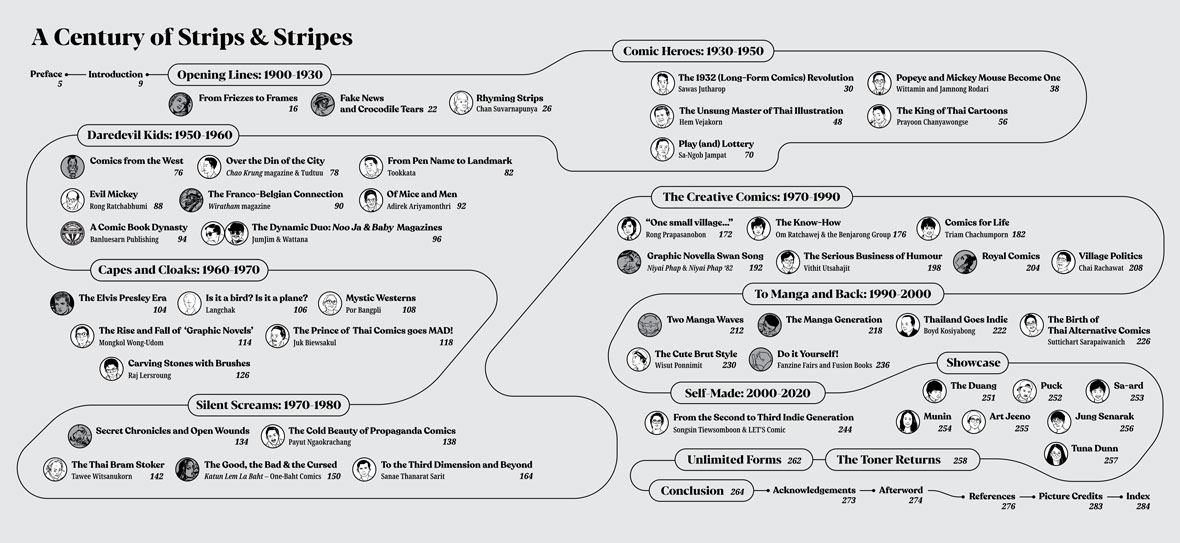
Royal Beginnings
Based on his findings, Verstappen relates the origins of Thai comics to members of Siamese nobility who traveled to Europe and were exposed to satirical art in the early 20th century. He mentions, in particular, King Vajiravudh, or Rama VI, who was educated in England and took an interest in political cartooning there.
Interestingly, back in Siam, Vajiravudh drew caricatures for the pages of royal gazettes and promoted drawing competitions among artists. “This is something I’ve seen nowhere else; the king was an artist himself and created cartoons,” Verstappen says, adding that this led to the first generation of political and editorial cartoonists in Siam in the 1920s.
It backfired though: the same cartoonists used their work to criticize the absolute monarchy of the time in the local press. Their ideas and objections were, for the first time, accessible to those who could not read and had a significant impact on general discontent, leading to the 1932 revolution, which inaugurated the now-established constitutional monarchy.
起源于贵族
Nicolas 发现,泰国漫画最早起源于 20 世纪初前往欧洲并在当地接触讽刺艺术的暹罗贵族。他特别提到了拉玛六世 Vajiravudh 国王,这位泰国国王曾赴英国留学,并对当地的政治漫画产生了兴趣。
有趣的是,回到暹罗后,Vajiravudh 在皇家公报上发行过一系列带有讽刺意味的漫画,并举办各种漫画艺术家比赛。Nicolas 表示:“这是我在其他地方前所未闻的,国王本人就是一位漫画家。正是这一切催生了 1920 年代的第一代泰国政治漫画家和社论漫画家。”
然而这一切最后适得其反:这一批漫画家利用他们的作品在当地媒体上抨击当时的君主专制。不识字的民众第一次了解到他们的想法和反对意见,社会大众的不满情绪一触即发,最终导致了 1932 年的政变,并建立了如今的君主立宪政体。
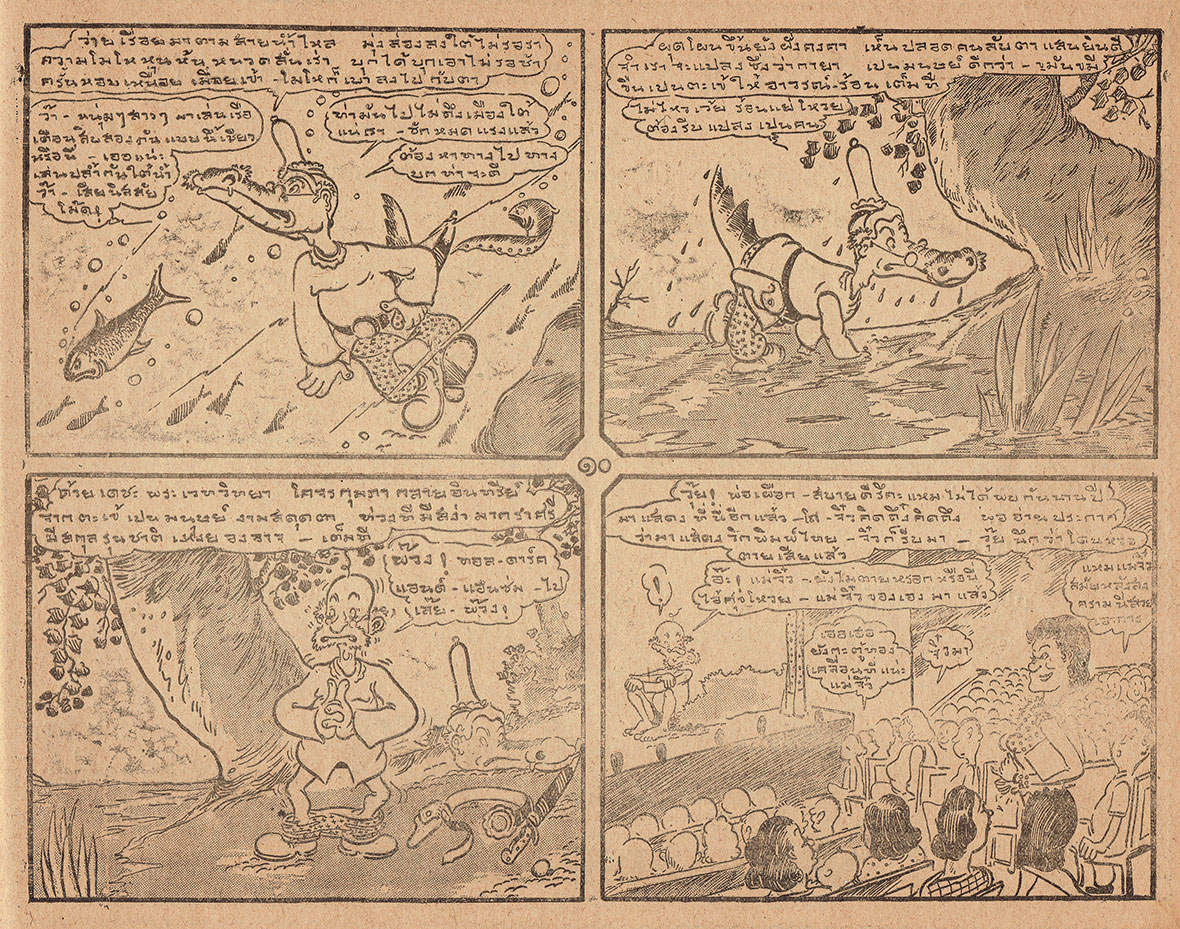
Historical Findings & a Uniquely Thai Genre
Ironically, press censorship was only intensified in the following decade. In the 1930s, a shorter satirical format gave way to longer-form, sometimes serialized comics. More visually sophisticated and realistic, these were primarily adaptations of epic Thai poems and folktales, but also stories that reflected the diverse spectrum of ethnicities and cultures that existed in the Kingdom. They also sowed a modern European lifestyle that began to penetrate Bangkok.
The misogynistic and racist tendencies of the time are evident in such comics, especially when viewed a century later. For instance, in some of them, we can clearly recognize the unbecoming place of women in society and the bigotry that took place against Chinese immigrants.
自成一派的开始
到了 30 年代,短篇讽刺漫画逐渐让位于长篇讽刺漫画,有时还会以连载漫画的形式出现。这些漫画在视觉上更加复杂和写实,主要是对泰国长篇诗歌和民间故事的改编,但也包括一些反映了泰国不同种族和文化的故事。除此之外,这些漫画还展示了开始渗透到曼谷的现代欧洲生活方式。
这些漫画里还充斥着赤裸裸的厌女和种族主义倾向,这些问题在一个世纪后的今天看来更为明显。例如,在其中一些漫画里,我们可以清楚看到女性在社会中较低的地位以及对中国移民的偏见。但与之同时发生的,是当地日趋严格的新闻审查制度。
Since Verstappen began working on the book, one name represented a mystery: Jamnong Rodari. He was held as an influential comics artist by everyone Verstappen spoke to about his project, but an artist whose work had virtually disappeared. “I had been researching for five years, and everybody was talking about his comics from 1932, but I had never seen any images. There was nothing available by Rodari in any collection, not one single surviving page,” Verstappen says.
“Then, a miracle happened,” he says. He received a call that someone had found a national treasure while cleaning an old attic: a box containing 1700 pages of 1930s comics including the lost works of Rodari. “It was an invaluable discovery. It changed history because everyone believed that Hem Vejakorn was the first to draw realistic cartoons, but Rodari did that before.” However, the discovery meant a lot more work for him. Since it all happened rather late, as he was about to finish the book, he had to revise the entire structure and connect the pieces once again.
Considering how easy it is for thin newspaper pages to deteriorate in the Thai climate, especially the humid monsoon months, it was remarkable to find Rodari’s work still kept in good condition. Adding to the mystery and allure of the find, the newspaper pages with the comics had been, at some point, amended with other pieces of paper glued to their backs. These pieces contained notes in English about other literary works. Who took them and who kept those Rodari specimens in the first place is still a mystery.
从 Nicolas 开始写这本书以来,有一位名叫 Jamnong Rodari 的漫画家一直是个谜。Nicolas 所采访的每个人都会提到 Jamnong Rodari,称他是颇具影响力的漫画家,然而这位漫画家的作品却已经无迹可寻。“我整整研究了五年,每个人都在谈论他 1932 年创作的漫画,但我从未亲眼见过 Rodari 的漫画,完全找不到他的任何痕迹,一页也没有,”Nicolas 说道。
“直到有一天,事情突然有了进展,”他说。有人给 Nicolas 打了一个电话,说在清理旧阁楼时发现了一件国宝:一个装有 1700 页 1930 年代漫画的盒子,其中包括 Rodari 曾经遗失的作品。“这是相当重要的发现,可能彻底扭转当地人对泰国漫画史的看法。以前所有人都认为 Hem Vejakorn 是第一个创作现实主义漫画的人,但其实 Rodari 比他更早。”然而,这一发现对他来说也意味着要投入更多的工作。由于这一切发生时已经接近项目的后期,本书也已将近完成,他不得不重新修改整本书的结构。
考虑到泰国的气候,尤其是在潮湿的季风天气,薄薄的报纸页面很容易损坏,而 Rodari 的作品至今仍然保持良好的状态,实在是非常难得。更令人觉得神秘和好奇的是,这些刊载漫画的报纸页还专门粘贴了英文注释。而究竟是谁完好地保存了这些刊登有 Rodari 作品的报纸,至今仍然是个谜。
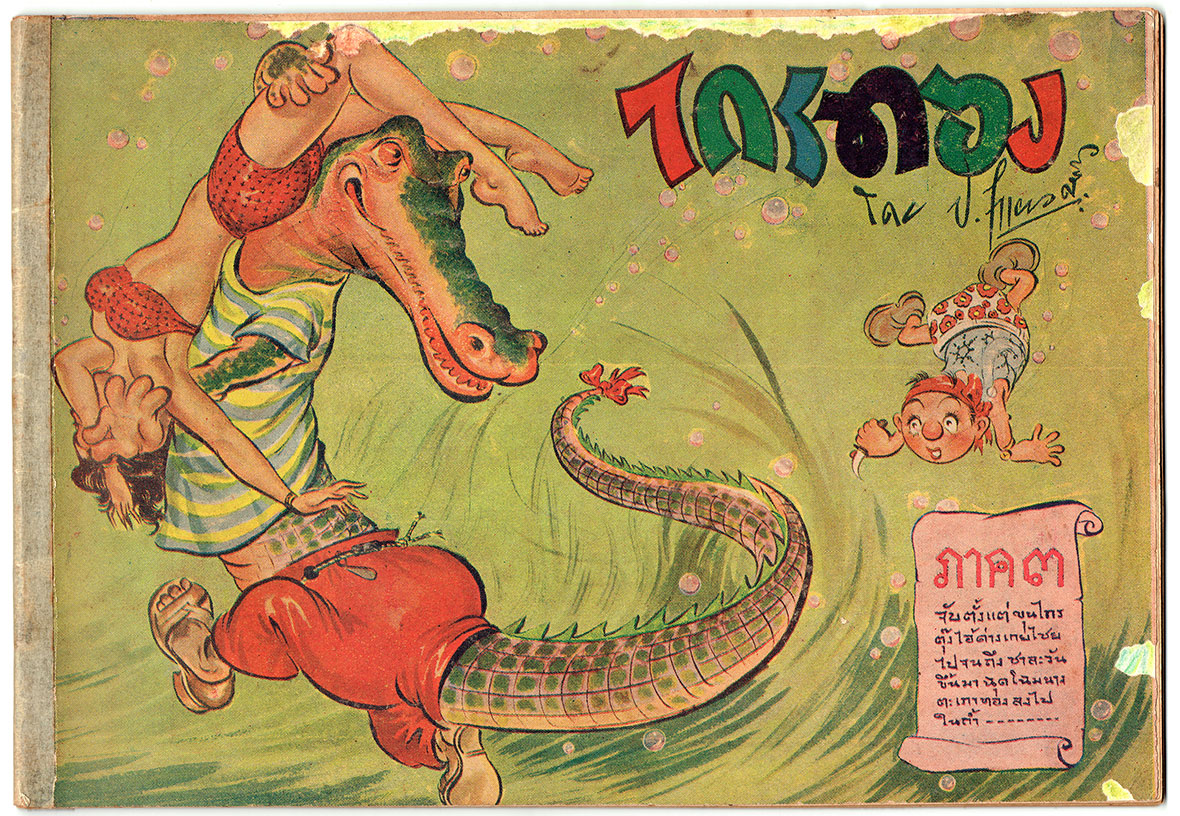
By the late 1930s, something truly unique to Thailand appeared in the medium. Prayoon Chanyawongse, considered the “king of Thai comics,” established the cartoon likay, a genre that places the reader inside the comics as if they were watching a performance of improvised theater. Likay is a uniquely Thai theater practice in which the audience takes part in the play’s direction, guiding the actors to improvise skits. “You can interrupt the play whenever you want,” Verstappen explains. “What’s amazing is that there is the space and freedom to make political commentaries during the play. Most of the stories were folktales, but you could add some references to modern times. It’s really a free form, and Prayoon was the one to use that and transfer it into comics.”
Cartoon likay is a dynamic, layered genre. Through the comics panels, the reader is taken into a play that switches from the setting of the theater to another embedded folk narrative, a device that emulates the actual likay experience. In a classical likay theater performance, the actors play with tones and the availability of homophones in the Thai language to make political commentaries. Likewise, Chanyawongse used this aspect to play with words and critique the abuse of power of the government of his time. These scathing critiques made him famous nationwide.
“Everyone saw these comics in the newspapers. They were sold in the villages; someone would buy a copy and pass it around. The higher classes would also read them, including a group of really defiant journalists and artists in Bangkok. Prayoon was the top star of his time,” Verstappen says. Chanyawongse’s work continued to be widely appreciated across society in the 1940s and 1950s, and the Thai tradition of comics at large also gained traction in those decades. “By the early 1960s, comics were everywhere, and everybody read them; children and adults. They become a part of daily life in Thailand,” Verstappen says.
30 年代后期,泰国漫画开始逐渐形成自己真正的特色。被誉为“泰国漫画之父”的 Prayoon Chanyawongse 创立了“Cartoon Likay”漫画流派,这类漫画让读者身临其境,仿佛是一出出舞台剧。“梨伽(Likay)”是一种泰国戏剧,观众可以参与到戏剧中,指导演员即兴创作和表演。Nicolas 解释道:“你可以随时打断表演。人们可以在戏剧中发表政治评论。大多数故事都是民间故事,但也可以加入一些现代元素。这是一种很自由的形式。Prayoon 巧妙利用了这一点,并将其转化到漫画中来。”
在传统 “梨伽” 戏剧表演中,演员通过使用音调和泰语同音字的玩法,来发表政治看法。同样,Prayoon 也利用了文字游戏的方式,以批判他那个时代的政府滥用权力的问题。漫画中直言不讳的批判使得他在泰国国内声名大噪。
Nicolas 说:“每个人都可以在报纸上看到这些漫画,偏远的乡下也可以买到,大家相互传阅。就连上层人士也会看,包括曼谷当地一众敢于挑战权威的记者和艺术家。Prayoon 是那个时代最耀眼的明星。”在 1940 年代和 1950 年代,Prayoon 的作品一直深受社会大众喜爱,而泰国漫画也在这几十年间获得广泛关注。“到了 1960 年代初,漫画无处不在,大人小孩都在看。漫画已经成为泰国日常生活的一部分,”Nicolas 说道。
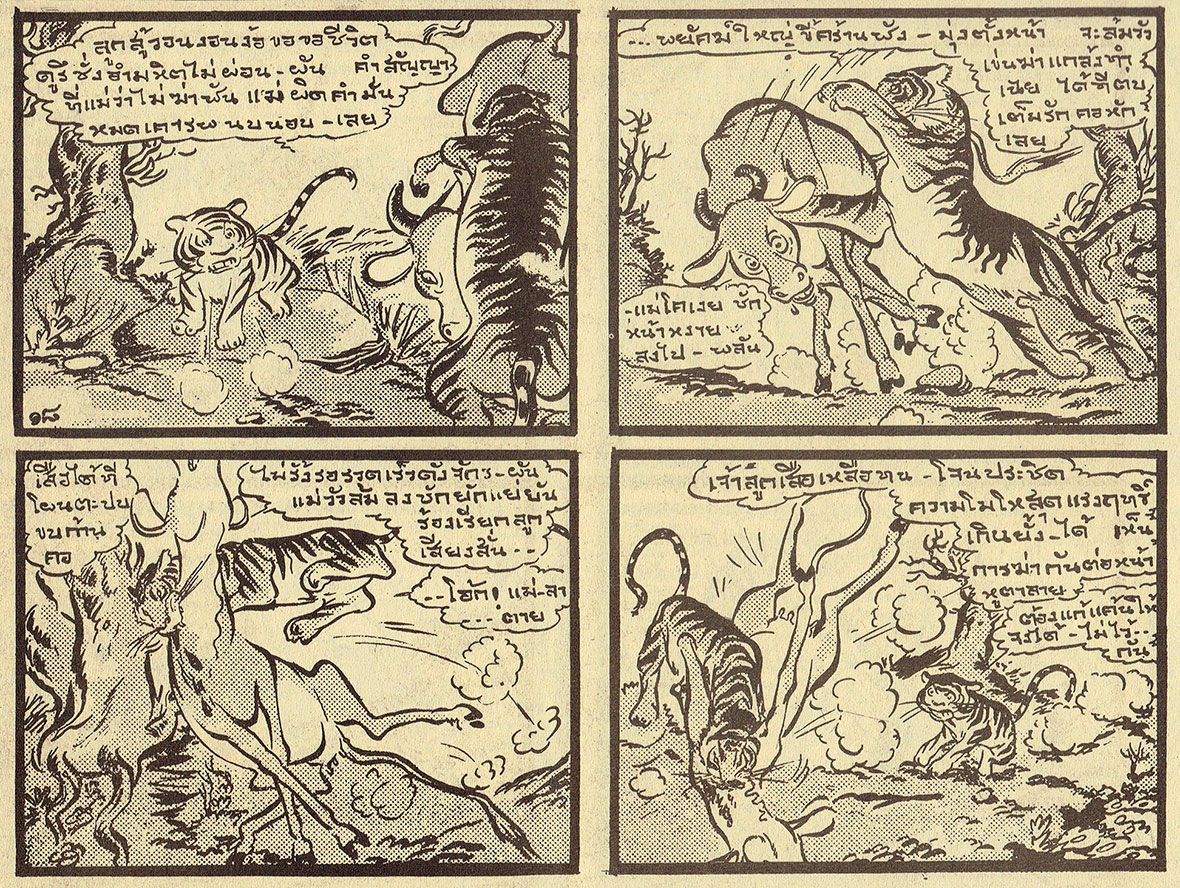
Rise of Middle Class, War, and Horror
In the late 1960s and 1970s, there was an economic boom that boosted the growth of the middle classes. Those who had just climbed the social ladder were in search of a new identity that, above all, would differentiate them from the lower classes. It was a very aspirational mentality, which led them to move away from reading comics. “There was a misconception that comics were easy to read, which is not true. Parents and teachers would say it was not like seeing a classic painting or reading classic literature, poetry, and so on. They would prefer highbrow culture, the type of art and culture seen in the court as if it would help them elevate in society,” Verstappen says.
The distancing of the middle classes from comics art was also defined by the rise of a new genre that swarmed the Thai market like nothing before: horror and gore. These short stories came in cheaply produced and in a small format for the meager price of one Baht—and they were sold by the millions.
中产的崛起、战争、恐怖与血腥
1960 年代末和 70 年代,经济繁荣促进了中产阶级的壮大。那些刚刚攀升社会阶梯的人想要寻找一种新的身份,藉此与下层阶级划清界限。在这种渴望成功的心态下,他们不再阅读漫画。“人们有一种误解,认为漫画是通俗、大众的,其实不然。家长和老师觉得看漫画不如看古典画作,不如读读经典文学、诗歌等,他们更喜欢高雅,那种‘上得了台面儿’的艺术和文化,仿佛这样能帮助他们提升社会地位,”Nicolas 说。
在中产阶级与漫画艺术撇清关系的同时,一种新的漫画流派随之兴起,并以前所未有之势横扫整个泰国市场,那就是恐怖和血腥漫画。这类短篇漫画制作成本低,篇幅小,价格仅为 1 泰铢,曾经销量达到数百万。
The 1970s were feverish times. First, there was an intense rural migration to the cities, especially Bangkok. Not graced by the economic boom, migrant workers faced the most undignified conditions in the capital, living and working precariously and with pitiful wages. At the same time, as the Vietnam war happened next door with all its horrors, Thailand was a place of “rest and recreation” for deployed American soldiers, which meant a rise in prostitution and drug use. The decade was also marked by anti-communist persecution, traumatic and bloody uprisings, and a military coup.
“The explosion in horror comics was a way to deal with all the violence that was happening. These topics were also taboo. You could not talk about the massacres. The killers were not arrested; they were amnestied,” Verstappen says. He adds that these horror stories were first read by most Thais, but then, with the middle classes distancing themselves from comics, and specifically from this type of violent, superstitious stories, they’ve become prevalent among the lower classes, including alienated low-wage workers and prostitutes.
“What’s interesting is that all these stories finish with some form of karmic justice, meaning that if someone does something wrong, they’ll get punished by the ghosts. Justice is always supernatural, but it’s still justice. For the readers, I think it felt like they would never get it in the real world, but they could feel better in thinking that there will be karmic justice in the future,” Verstappen says.
1970 年代是狂热的。农村人口大量涌入城市,尤其是曼谷。农民工并未受惠于繁荣的经济,在这座首都城市里,他们身处最不体面的环境,生活和工作动荡不定,拿着微薄的工资。与此同时,越南战争的爆发,使得作为邻国的泰国成为美国士兵的“后花园”,卖淫和吸毒的现象与日俱增。除此之外,反共迫害、血腥革命事件以及军事政变在这十年期间接踵而来。
Nicolas 说:“恐怖漫画的兴起成为了人们应对当前各种暴力事件的一种方式。这些话题本身就是禁忌。人们不能谈论大屠杀。杀人的凶手也没有被逮捕,而是获特赦了。”他补充说,刚开始大多数泰国人都会看这些恐怖漫画,但随着中产阶级远离漫画,特别是这类暴力、迷信的漫画故事,这类漫画就只要流传于下层阶级,譬如处于社会边缘的廉价工人和妓女。
“有趣的是,这些漫画故事最后都会以某种形式的因果报应作为结局,也就是说,做错事的人会受到鬼神的惩罚。正义总是以超自然的形式存在,但仍然是正义的。对于读者来说,我感觉是他们无法在现实世界里实现正义,但可以安慰自己,未来会通过因果报应来伸张正义,”Nicolas 说道。
Japanese Manga and the Collapse of Thai Comics
In the late 1960s, the first manga was translated to Thai, starting a wave that would seriously disrupt the local comics market. Everything started with collaborations between Thai and Japanese publishers. Mangas were not only translated but they were also flipped: from right to left, as it’s common in Japan, to left to right, as people read in Thailand. Osamu Tezuka, the creator of Astro Boy, even wrote a personal letter to Thai readers introducing his comics Jungle Emperor Leo and thanking his collaborators in the country. By the 1970s, a proper manga craze was established in Thailand—a fierce competition that didn’t please local comic artists.
To make things worse, what started as licit collaborations quickly descended into widespread piracy. Japanese mangas were translated and copied in cheap bootleg issues without regard to copyrights, and their selling price was even lower than any Thai production. “In ten years, from the mid-1980s to the mid-1990s, the Thai market was destroyed, and all major cartoonists just retired because they could not compete with the piracy of Japanese mangas,” Verstappen says.
The year 1995 brought relief. There was a new copyright agreement between Thailand and Japan that fought back against piracy. That raised manga prices and established a fairer scenario for competition. Still, by that time, the new generation of Thai artists was heavily influenced by what they saw in mangas and reproduced the style in their comics. By the early 2000s, Thai manga-style stories had taken over the mainstream scene.
日漫的冲击与泰漫的衰落
1960 年代末,第一部日本漫画被翻译成泰语,由此开始对当地的漫画市场的严重冲击。泰国和日本出版商展开密切合作,不断有日本漫画不仅被翻译成泰语,甚至连排版也按照泰国阅读习惯进行了优化:从原来的“从右到左”(日本大众普遍阅读顺序)变成“从左到右”(泰国大众普遍阅读顺序)。《阿童木》的作者手冢治虫甚至给泰国读者写了一封私人信,介绍他的漫画《小白狮王》,并向他在泰国的合作者表达了谢意。70 年代末期,泰国掀起了一股真正的日本漫画热潮,这对于当地漫画家来说是非常残酷的现实。
更糟糕的是,合法正当的合作产品很快演变为猖獗的盗版行为。人们不顾版权问题,将日本漫画翻译和复制成廉价盗版漫画,其售价甚至低于泰国本地作品。“十年间,从 1980 年代中期到 1990 年代中期,泰国本土漫画市场土崩瓦解,就连一些知名的泰国漫画家也因为无法与盗版日漫竞争而退出了市场,”Nicolas 说道。
情况到 1995 年才有所缓解。泰国和日本之间达成了一项新的版权协议,以打击盗版现象。这一措施提高了漫画价格并营造了更为公平的竞争环境。但在这个时候,新一代的泰国漫画家已经深受日本漫画的影响,他们在漫画创作中也往往遵循类似的风格。到 2000 年代初,日漫风格已在泰国占据了主流地位。
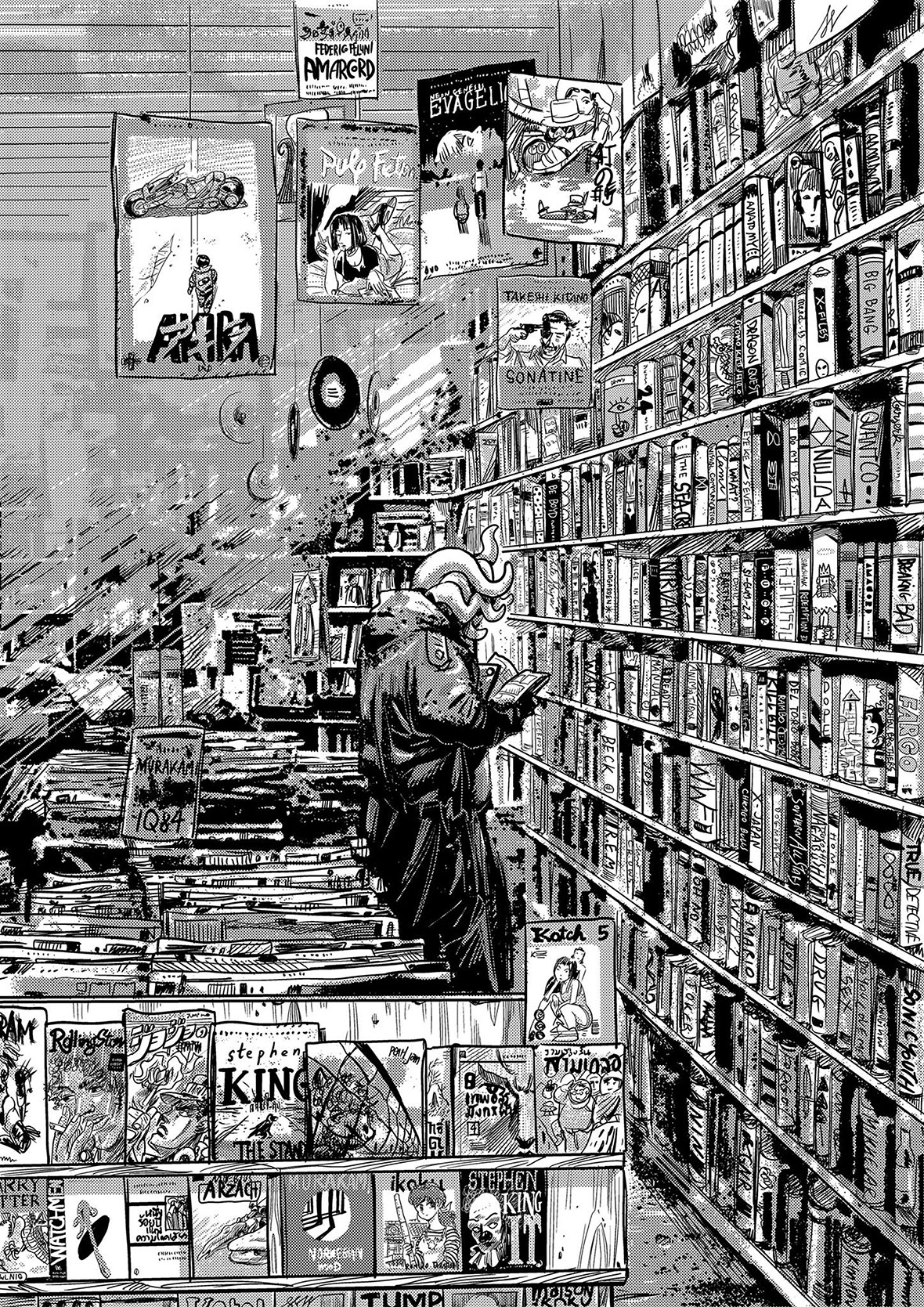
The Indie Generation
Even if the local production of manga-styled comics incorporated traces of Thai culture and folklore, many Thai artists didn’t see themselves in what was created in the mainstream. Hence, an independent scene appeared in the late 1990s with works that varied in both style and narrative but that exuded a sense of cultural hybridism. They mixed global cultures and identities while reflecting modern metropolitan life in Thailand.
It was around the same time, following the 1997 Asian Financial crisis, that a culture of DIY fanzines flourished. They were sold by their creators in markets and alternative festivals, from music to art, catering to a much smaller, although trendier, audience.
The indie scene defined Thai comics throughout the 2000s. But then another blow. The Covid-19 pandemic hit with an extended halt in festivals, book fairs, and gatherings of any sort. Even Thai schools and universities, the breeding ground of many indie artists, turned online. Money people were willing to spend on entertainment was sharply lower because of the economic crisis that descended upon Thailand with the pandemic. As a result, Verstappen notes that quite a few Thai cartoonists turned to NFTs as an easier way to keep afloat and earn a living.
Still, the scene is resilient, and what does not kill you makes you stronger. That’s certainly true regarding the current socio-political turmoil Thailand is going through and the effects on local art. “More and more young Thai artists are making small publications like zines, and even documentary comics related to the issues they face. They talk about many topics, from women and LGBTQ+ rights to challenging rape culture,” Verstappen says. He also remarks that the surging wave of comics is notably more politically motivated than when he started his research six years ago.
Verstappen believes that self-publishing and the small press scene will make a strong comeback. “After two years of lockdown, when everything was online and dematerialized, the young generation feels the need to go back to print and sell their own books. They want to use any print techniques to create objects, books, something they can hold,” he says.
独立世代
虽然偏日式风格的泰国本地漫画也会融入一些泰国文化和民间传说元素,但对于许多泰国艺术家而言,这些主流漫画并不能体现他们独有的特色。1990 年代后期,泰国独立的漫画圈子逐渐形成,他们的作品在风格和叙事上各不相同,但充满了文化混合感。他们既有全球化的文化与身份,同时又能反映泰国的现代都市生活。
大约在同一时期,继 1997 年亚洲金融危机之后,DIY 式的同人志文化蓬勃发展。同人志创作者在市场和各种节日活动出售自己的音乐和艺术作品,以迎合更小众,但更新潮的观众。
整个 2000 年代,独立漫画成为了泰国漫画的基调。但很快,又一个冲击接踵而至。新冠疫情的爆发导致各种节日活动、书展和聚会被迫取消。就连原来作为独立艺术家培养中心的泰国学校和大学也转为线上授课。由于疫情对泰国造成的经济危机,人们在娱乐方面花费的意愿也急剧下降。Nicolas 指出,为了更好地维持生计和谋生,相当多的泰国漫画家因此转向了 NFT。
尽管如此,泰国漫画仍然展现出蓬勃的生命力,正所谓:无法击溃你的一切只会造就更强大的你,“越来越多的年轻泰国艺术家开始创作电子杂志之类的小型出版物,甚至还有根据自己的故事创作的纪录片式漫画。他们在漫画中探讨各类社会话题,包括女权、LGBTQ+ 平权运动以及对强奸文化的抵制等等,”Nicolas 说道。他还表示,与六年前自己刚开始这个项目时相比,现在明显涌现了越来越多更具政治动机的漫画。
Nicolas 相信,自助出版和小型媒体将强势回归。“在过去两年的封锁期间,一切转移到线上和非物质化,但现在年轻一代渴望回归实体的印刷物,出售自己的书。他们想运用各种印刷工艺来创造事物、书籍或任何可以拿在手上的东西,”他说。
A need to go back to physical, tactile forms of entertainment would hopefully spike a renewed interest in the art of comics outside the more underground scenes, not just in Thailand, but globally. In the age of online streaming, Verstappen believes comics hold inherent qualities that are good for the brain. “Recent studies have shown that reading comics is actually more challenging than reading text only. We have to figure out how text and image work together and how all the other images work together. This is a demanding process to our brains,” he says. He’s also an enthusiast of the capacity comics have to challenge the status quo through exciting and visually engaging narratives.
Ultimately, the combination of drawing and text opens up endless possibilities for self-expression and social critiques, from autobiographical stories to documentaries. Broadening the horizons even further, Verstappen refutes the idea that artists need to stick to a format, like always drawing inside panels, for instance. The notion of what defines comics is broader, more abstract, and virtually impossible to pinpoint. To him, it’s not about panels or even a narrative sequence. It’s more about a “visual solidarity,” as he puts it, that happens within the work and between the depictions, one that conveys a message on its own and unites all pages non-linearly.
渴望回归实体形式的需求,有望重新激发人们对于漫画艺术的兴趣,不仅仅是在泰国,在全球各地同样如此。在这个线上流媒体时代,Nicolas 认为看漫画是一件兴奋大脑的事。他说:“近期的研究表明,看漫画实际上比只阅读文字更具挑战性,因为你要弄清楚文字与图画如何结合,以及其他图画之间如何组合。这对我们的大脑来说是一个有难度的过程。”此外,他还热衷于探讨漫画如何通过精彩和引人入胜的视觉叙事来挑战现状。
归根到底,从自传故事到纪录片漫画,图画与文字的结合能为自我表达和社会批判开辟无限的可能性。Nicolas 从更开拓的视角出发,驳斥了艺术家需要恪守一种漫画形式的想法。漫画的概念其实更广泛、更抽象,没有条条框框。用他的话来说,更重要的是作品和图画中的“视觉一致性”,能够独立传达信息,并将所有画面以非线性的形式串联起来。
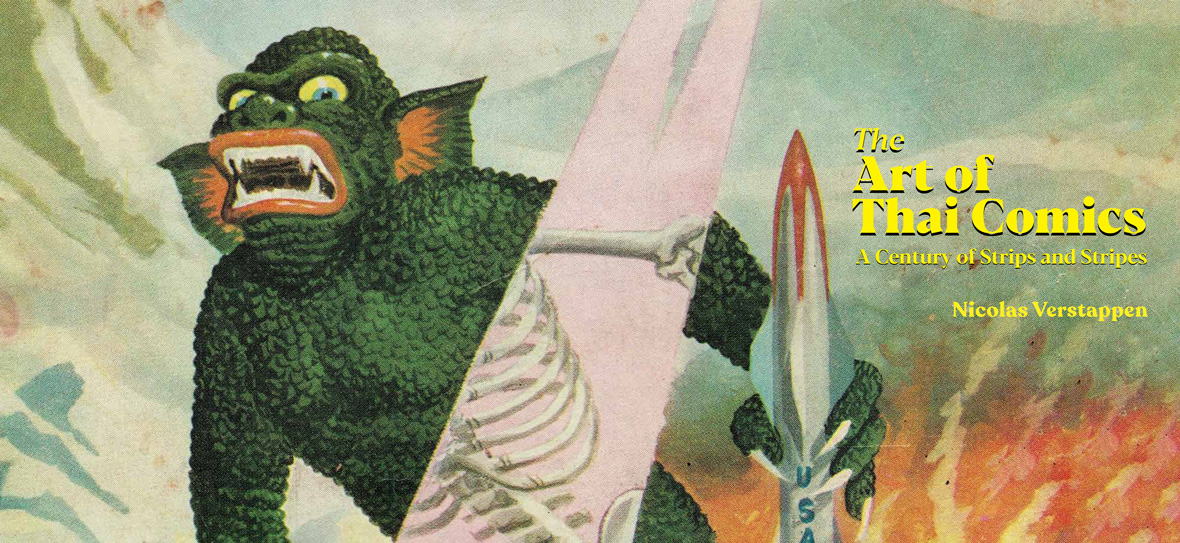
The pages of The Art of Thai Comics are connected linearly, though. The book is organized in chronological order in chapters divided by time periods, featuring the fifty artists whose works he analyzes. Furthering his homage, he included their sketched portraits and, when available, also their trademark signatures. To make the evolution of Thai comics more apparent to the reader, Verstappen included two graphical timelines; one illustration loop on the inside cover, and another with the portraits of the artists as content pages. All illustrations are by designer Peeraphat Kittisuwat, whose work already revolved around looping narratives.
The extensive historical background the book provides made the writing process all the more complex and lengthy. “I wanted to give context to everything. Every time there was a page with references, like politics, royalty, or the likay theater, I needed to explain everything to the readers,” Verstappen says. Initially, he wrote the book in English with an international audience in mind. But it quickly became clear that a translation to Thai was needed—another complex task that took six months to accomplish.
The translation became absolutely necessary to Verstappen as his work progressed. Realizing that the path for new Thai comics artists was challenging, with little support, resources, and visibility, he felt the need to connect them to the rich tradition of comics that had been almost completely forgotten. “In the past, there were masters with incredibly high-level work. They created unique things no one was doing in the United States, Europe, or Japan. They impacted society and their governments. I wanted to give young Thai artists a sense of legacy and show them that, even if they might feel alone now, they are part of something bigger,” Verstappen says.
The Art of Thai Comics is now available for purchase on Amazon.
不过作为一部历史读物,《泰国漫画艺术》则以线性形式编写。全书按时间顺序,以不同时期划分章节,一共介绍了 50 位艺术家,包括 Nicolas 对每位艺术家的作品分析。为了进一步表达敬意,他还在书中附上了艺术家的素描肖像以及他们的签名。为了帮助读者更好地了解泰国漫画的演变,Nicolas 制作了两条生动形象的时间线。所有插图均出自设计师 Peeraphat Kittisuwat 之手。
本书涉及漫长的历史背景,整个写作过程也因此复杂而艰辛。Nicolas 说:“我想为所有内容提供背景信息。每次提及参考资料,例如关于政治、皇室或“梨伽”戏剧的内容,我都需要向读者解释背景的来龙去脉。”目前,图书仅有英文版本,不过马上计划翻译成泰语,需要六个月才能完成。
在这本书的创作过程中,Nicolas 也逐渐意识到翻译的必要性。新生代泰国漫画家面临诸多挑战,缺乏支持、资源和关注,他希望藉此帮助他们与一度失落的丰富泰国漫画传统相联系。“过去,这里曾有多位漫画大师,他们有着过人的作品水平,创作出在美国、欧洲或日本都没有的独特作品,影响着整个社会和政府。我想让年轻的泰国艺术家感受传承的力量,让他们知道,虽然现在可能感到孤立无助,但他们的努力有着更宏大的意义,”Nicolas 说道。
《泰国漫画艺术》目前可在亚马逊(Amazon)平台购买。
Like our stories? Follow us on Facebook and Instagram.
Instagram: @nicolasverstappen
Contributors: Tomas Pinheiro
Chinese Translation: Olivia Li
Images Courtesy of Nicolas Verstappen, Family of Juk Biewsakul, River Books Illustration, Thai Watana Panich, Mongkol Wong-Udom, Prayoon Chanyawongse Foundation, Thaweeporn ‘Thong’ Janekoonthongkambai, Vibulkij Publishing, and Suttichart Sarapaiwanich
Instagram: @nicolasverstappen
供稿人: Tomas Pinheiro
英译中: Olivia Li
图片由 Nicolas Verstappen、Family of Juk Biewsakul、River Books Illustration、Thai Watana Panich、Mongkol Wong-Udom、Prayoon Chanyawongse Foundation、Thaweeporn ‘Thong’ Janekoonthongkambai、Vibulkij Publishing 与 Suttichart Sarapaiwanich 提供

